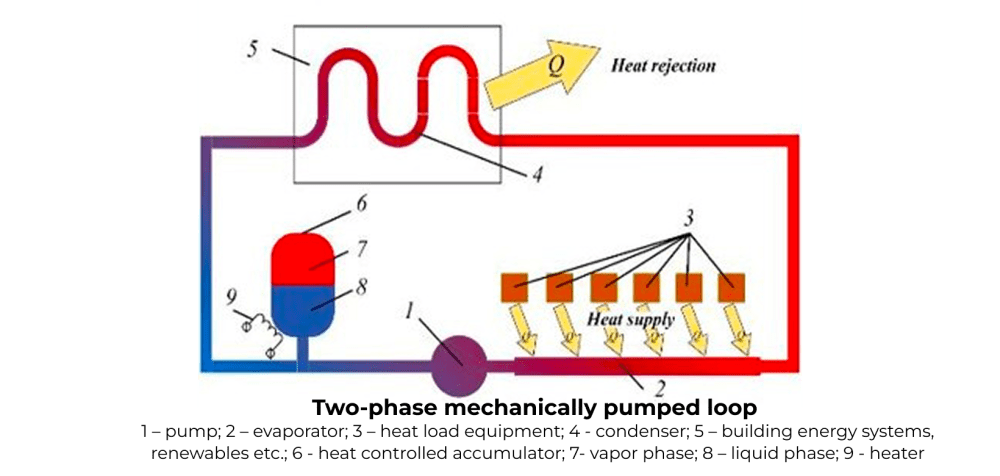There is a growing trend of increasing total power capacity and volumetric heat density in modern data centers. Next-generation electronic components generate high heat fluxes, requiring advanced and efficient cooling methods. The low energy efficiency of traditional air-based cooling systems is driving the shift toward immersion and liquid-based cooling solutions.
The most radical and effective approach involves the use of mechanically pumped two-phase cooling technologies for heat removal and rejection to the environment.
"The data center cooling market will shift from single-phase water cooling to two-phase systems within the next 2–5 years.“ — US Data Center Conference 2024
Two-phase mechanically pumped systems (2PH-MPL) have a low overall thermal resistance for heat dissipation to the environment, enabling year-round operation in free cooling mode (without chillers), achieving PUE values below 1.03–1.1.
2PH-MPL can be integrated with single-phase liquid and immersion cooling, as well as secondary heat recovery subsystems. The system is suitable both for new data center builds and for modernization or capacity upgrades of existing facilities.
Our company has over 30 years of experience in developing mechanically pumped two-phase cooling systems for space and terrestrial applications, including key components like cold plates, heat exchangers, hydraulic accumulators and others.
For 15+ years, CTPH collaborated with Thales Alenia Space – France on advanced cooling systems for high-power satellites, leading to the 2021–2022 launches of SES-17 and Eutelsat Konnect VHTS (1 world GEO satellites with 2PH-MPL).
For 2PH-MPL thermal management an adaptive control systems is used, which is a proprietary approach based on comprehensive computer modeling of the entire system. This allows all design solutions and control algorithms to be virtually validated before commissioning, significantly reducing startup time and costs. The integrated model ensures optimal efficiency across all operating modes and conditions, while real-time monitoring data enables personnel to make prompt, informed decisions. As a result, energy consumption can be reduced by up to 20–30% annually, equipment lifespan is extended, and faults—both existing and emerging—can be detected and resolved quickly through continuous monitoring.
Explore Proven Solutions for Tight Packed Electronics with High Dissipation Power.
Like this entry?
-
About the Entrant
- Name:Rustem Turna
- Type of entry:teamTeam members:
- Gennadiy Gorbenko
- Oleksii Bechko
- Yevhen Rohoviy
- Software used for this entry:Adaptive control systems is used, which is a proprietary approach based on comprehensive computer modeling of the entire system.
- Patent status:pending
.png)


.png)


.png)


